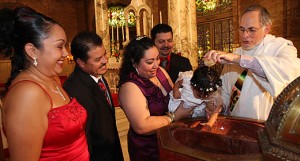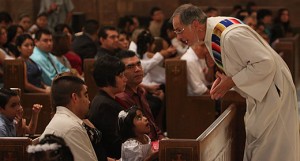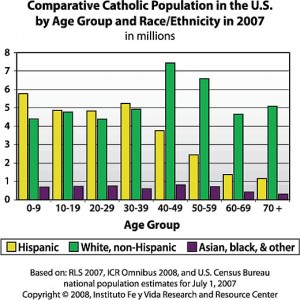
Six hundred Latinos christened yearly at Minneapolis parish
Extended families greet one another with hearty handshakes and pecks on the cheek as they file in to Incarnation church in Minneapolis on a recent Saturday morning.
Professional photographers and videographers scope out ideal vantage points while moms and dads snap photos of their kids in front of flowery side altars. Toddlers dressed in white gowns and three-piece suits squirm in their parents’ arms.
About 15 minutes after the ceremony is scheduled to begin, Deacon Carl Valdez leads the congregation in an opening hymn, explains in Spanish the importance of what is about to occur, then invites families to line up in front of the altar.
Time after time, Deacon Valdez says a blessing as he carefully pours water over each child’s head. By the end of the hour-and-a-half ceremony, he has baptized 28 children.
600 baptisms
It was a typical Saturday for Incarnation’s Spanish-speaking Sagrado Corazón de Jesús community, which celebrates approximately 600 baptisms per year — more than any other parish community in the archdiocese.
Deacon Valdez remembers the first time he was called to do baptisms at Incarnation three years ago, just before he was assigned to the Minneapolis parish. “It was a hot day,” he recalled. “I walked in and there were 54 kids to baptize.”
Since then, Deacon Valdez has reduced the number of baptisms he’s willing to perform at one time in an effort to better prepare families for the sacrament. Parents and godparents are required to attend a three-to-four-hour class, where they learn about the sacraments and the symbols involved. If the child to be baptized is old enough, he or she also receives instruction.
Deacon Valdez realizes that many of the families whose children he baptizes are not regular church goers. And, some parents aren’t married. But he uses the opportunity to gently inform them of their responsibilities as Catholics. Then he invites them into full communion with the church.
“At least we can say in an inviting way, not in a chastising way: ‘You are saying you want to live your Catholic faith because you’re baptizing your child. How are you living your faith?’” Deacon Valdez said.
An estimated 3,000 families belong to Sagrado Corazón, which the archdiocese classifies as a chaplaincy rather than a separate parish.
The Sagrado Corazón community originates from St. Stephen in Minneapolis, which began offering weekly Masses in Spanish in 1992. Five years ago, the community moved to Incarnation after it had outgrown St. Stephen. On a typical weekend, about 1,400 people attend one of theparish’s four Spanish-language Masses.
Although many of the Latino immigrants who attend Spanish-language Masses at Incarnation are bilingual, Deacon Valdez said he considers it a “God-given right” for people to worship “in their own language, according to their own culture.”

One church
For years, the two communities sharing a worship space at Incarnation have maintained separate identities, even separate names. However, leaders at the parish are taking steps to change that.
“We’ve made moves to say it’s ‘we,’ not ‘we and they,’” Deacon Valdez said.
The two communities now participate in joint staff meetings. “So that’s a small start,” he said. “But one day I’m sure we’ll be called Incarnation again instead of Incarnation/Sagrado Corazón.”
“We do not want parallel parishes,” said Estela Villagrán Manancero, a member of the archdiocesan Parish Services Team who specializes in Latino ministry.
The goal, according to Villagrán, is to integrate rather than assimilate. The two communities eventually would be seen as members of one parish, but with Masses in both English and Spanish.
“We can respect each other’s cultures and our native languages all under the same roof,” she said.
Villagrán said she believes the Latino community has much to offer to the archdiocese. “For example, the way we honor family,” she said. “Then there is the popular religiosity — posadas, celebrations, etc. And, our Masses are full of life and joy.”
 Growing numbers
Growing numbers
Every weekend, about 16,500 people attend Spanish-language Masses in 23 churches throughout the archdiocese, the Parish Services Team reported in 2008. Villagrán said she believes that number has grown considerably in the past year and a half and will continue to grow into the future.
In 2009, Latinos made up 40 percent of the U.S. Catholic population, according to Instituto Fe y Vida, a Catholic non-profit organization.
Fifty-six percent of Catholics under age 10 are Latino, and nearly half of Catholics between the ages of 10 and 29 are Latino, the organization reported last year.
Although the number of Latino Catholics in Minnesota is not as high (in 2006, 18 percent of Catholics under age 18 in the state were Latino), it is still significant, Villagrán said. And, if parishes do not make an effort to reach out to Latinos, the Catholic Church could lose them.
In Red Wing, Villagrán offered as an example, “there are five evangelical churches knocking on [Latino] people’s doors and luring them in. Since we don’t have Bible studies or anything to offer [in Spanish], not even a priest who can celebrate the Mass [in Spanish] regularly, we are losing so many people.”
St. Joseph in Red Wing recently hired a part-time Latino ministry coordinator who has started Spanish faith formation and youth ministry programs. But the need for more is great, Villagrán said.
At Assumption in Richfield, 175 Latino children are preparing for first Communion. But the parish’s faith formation director is part time and doesn’t have enough Spanish-speaking catechists to meet the demand, Villagrán said.
There is also a critical need for priests who are proficient in Spanish, she added.
The St. Paul Seminary now requires students to study Spanish in Mexico for eight to 12 weeks, spend two weeks at the archdiocesan mission in Venezuela, complete a course in Latino ministry, and get experience in Latino ministry at a parish.
While almost all new priests are able to say Mass in Spanish, knowing the language well enough to give a homily or hear confessions in Spanish is another matter.
A maturing ministry
For 15 years, the archdiocese has subsidized Latino ministry in parishes. Beginning July 1, however, the subsidy was reduced by one-third. Over the next two years, archdiocesan funding for Latino ministry will be withdrawn completely as part of a plan arrived at in consultation with pastors and other parish leaders, said Jim Lundholm-Eades, director of the Parish Services Team.
“It’s clear that the leadership of the Latino Catholic communities is ready for it,” Lundholm-Eades said. “They have the training, they have the commitment, and they’ve been doing this for a long time. It’s matured to the point where we can let go . . . and turn over the financial responsibility to the local level.”
To prepare for this change, seven years ago the archdiocese began offering a leadership development program to train lay people in the Latino community for positions in youth ministry, faith formation and other areas of parish life. To date, about 120 people have completed the 18-month program.
Archbishop John Nienstedt also has demonstrated a personal commitment to Latino ministry. Last month he spent two weeks in Mexico studying Spanish. “Symbolically, that’s a message to his priests and to the Latino people that he’s serious about Latino ministry,” Lundholm-Eades said.



